Content
Peppermint does not occur in nature. This is a hybrid of speckled and water mint, isolated in a separate species, obtained at the end of the 17th century in England. It is he who serves as a medicinal raw material for the pharmaceutical and perfumery industries, since it contains the most menthol and essential oils. The medicinal properties and contraindications of peppermint are well known to official medicine and herbalists.
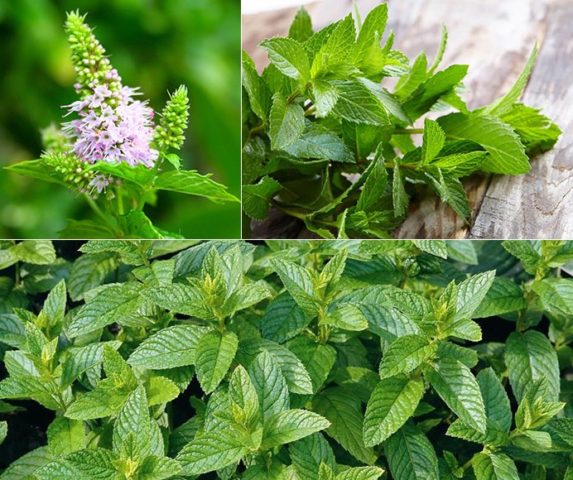
Only peppermint is used as a medicinal raw material
The chemical composition and value of peppermint
Peppermint, in Latin - Menthapiperita, the international scientific name Mentha × piperita, is a valuable medicinal plant. In countries with warm climates, it is grown on an industrial scale, but the demand for raw materials is constantly growing.
The pharmacognosy of peppermint makes Russian varieties one of the best, and the conditions of the southern regions are suitable for plant development. There, two full-fledged crops are harvested per year, each time receiving after processing 17-18 centners of dry leaves per hectare. The high cost of raw materials, steadily growing demand make the crop attractive for industrial cultivation by both large farms and small farmers.
The medicinal properties and use of peppermint are due to its composition. For the pharmaceutical industry, the high content of essential oils in the aerial part is of greatest importance - from 3 to 5.5%. Of these, in turn, 50-60% falls on menthol.
Peppermint contains the most volatile compounds in the initial stage of flowering:
- leaves - up to 3%;
- flowers - 4-6%.
But it is not only the strong menthol smell and the high content of volatile compounds that make it possible to distinguish peppermint from ordinary mint. The leaves of the first have a cooling effect on the nerve receptors, the second has a warming effect.
Peppermint is not limited to menthol and essential oils. It contains:
- nutrients, including essential minerals and vitamins;
- flavonoids;
- organic acids;
- betaine, which is involved in cell synthesis and is a hepatoprotector;
- polyphenols;
- anthocyanins.
Vitamin content in peppermint
Peppermint's properties are largely due to its vitamin content. Per 100 g of dry leaf, in mg:
- vitamin A - 0.212;
- thiamine (B1) - 0.082;
- riboflavin (B2) - 0.266;
- pantothenic acid (B5) - 0.338;
- pyridoxine (B6) - 0.129;
- folates (B9) - 0.114;
- ascorbic acid (C) - 31.8;
- vitamin PP - 1.706.
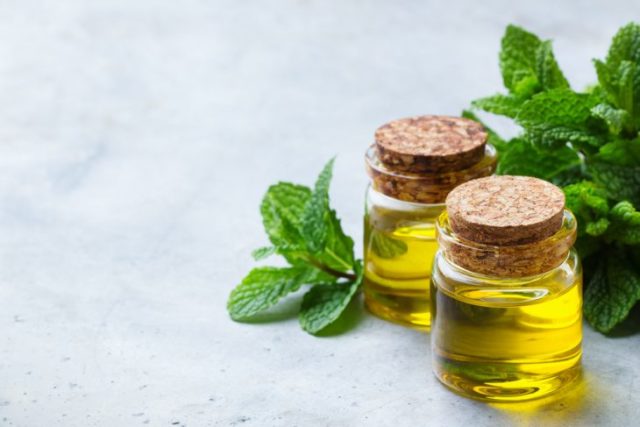
The content of essential oils in peppermint is incomparably higher than that of other species
The health benefits of peppermint
Even the smell of culture heals - invigorates the tired, calms the irritated, stimulates brain activity in brain workers and students. The properties of peppermint are still being investigated, for example, the antineoplastic ones are interesting. Of those already well studied, the most important are:
- sedatives;
- antispasmodic;
- vasodilators;
- antibacterial;
- anti-shock;
- antipyretic;
- antiviral;
- diaphoretic;
- irritating nerve endings;
- pain relievers;
- choleretic;
- anti-inflammatory;
- improving digestion and intestinal motility;
- absorbable;
- immunostimulating;
- vasoactive (affecting the diameter of the lumen and the tone of blood vessels);
- diuretics;
- laxatives;
- anthelmintic;
- expectorant;
- tonic;
- reducing the secretion of gastric juice;
- enhancing the reflex activity of the endocrine glands.
The healing properties of peppermint for men
Some members of the stronger sex are afraid to drink mint tea, because it supposedly reduces potency. At the same time, the herb is considered an aphrodisiac.
For men, a small cup of mint tea is enough to boost libido. Excessive amounts act as a sedative, so it depends on the dose. Peppermint does not reduce potency, it just soothes, disinhibits, relieves stress. After a hard day, naturally, this causes drowsiness.
Another male concern is that peppermint lowers testosterone levels. This is true, but in order for the content of the hormone in the body to fall, you need to drink several cups of strong infusion of the herb, not tea, for a long time every day.
It has been experimentally established that peppermint immediately after consumption reduces sperm activity. A little, for a short time. So it cannot even be considered a contraceptive.
Mint is a medicinal plant. Do not forget about this, use it in moderation. Then the beneficial properties and contraindications of peppermint for the body of men will be incomparable.
As a nice bonus, weed will help:
- get rid of dandruff;
- freshen your breath;
- reduce sweating.
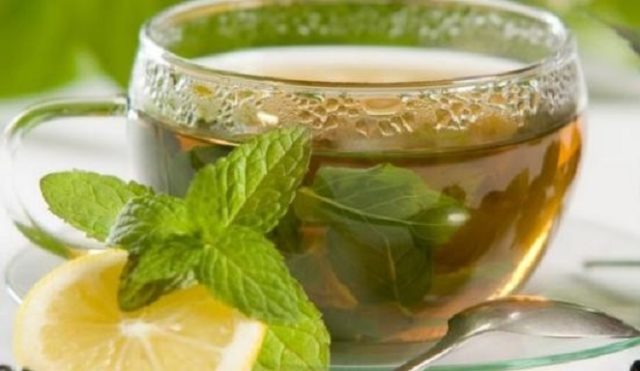
A cup of mint tea can only benefit men
The healing properties of peppermint for women
Some peoples call mint a female herb. It actually lowers the level of male hormones. And if the stronger sex needs to drink grass in liters in order to achieve noticeable changes, then for women a large amount of testosterone in the body is unnatural. To reduce it, it is often advised to drink mint tea before prescribing medications. Especially when the cause of hormonal disruption lies not in a serious illness, but in stress, improper lifestyle, and taking certain medications. This often helps, including reducing hirsutism.
It is impossible to diagnose and treat yourself on your own - hormonal imbalance can be caused by various reasons. The same hirsutism is the first and most harmless sign of serious diseases, for example, ovarian dysfunction. In order not to remain sterile, a woman should receive a full-fledged treatment, in which mint will act as an adjuvant. Doctors usually do not protest, but rather welcome the inclusion of this herb in therapy.
Peppermint normalizes the monthly cycle. On the one hand, it stops uterine bleeding, on the other hand, it increases the scanty discharge.
Benefits of peppermint during pregnancy
The benefits and harms of peppermint for women who are expecting a baby depend on the dose. If the expectant mother drinks 1-2 cups of tea with a couple of fragrant leaves a day, this will only help the successful course of pregnancy:
- has a beneficial effect on the nervous system, reduces anxiety;
- helps to get rid of the satellites of toxicosis - nausea, dizziness;
- improves the activity of the gastrointestinal tract, relieves heartburn, bloating, constipation;
- reduces pressure;
- thanks to its antibacterial and antiseptic properties, it treats mild forms of colds without medication;
- relieves puffiness.
Among the contraindications - intolerance to menthol and other components that make up peppermint. Do not drink tea in large doses. Starting from week 36, it must be abandoned altogether, unless the doctor advised otherwise.
Among other contraindications for self-administration of peppermint for pregnant women:
- low pressure;
- any problems with the kidneys, liver.
Why is peppermint good for breastfeeding
Peppermint reduces lactation. When breastfeeding, you can not drink tea with it, use cough syrup and lozenges, which contain components of the herb, to treat throat diseases.
But peppermint will be useful at the stage of weaning a baby from the breast. The herb has shown high effectiveness in the treatment of mastopathy, especially caused by milk stagnation.
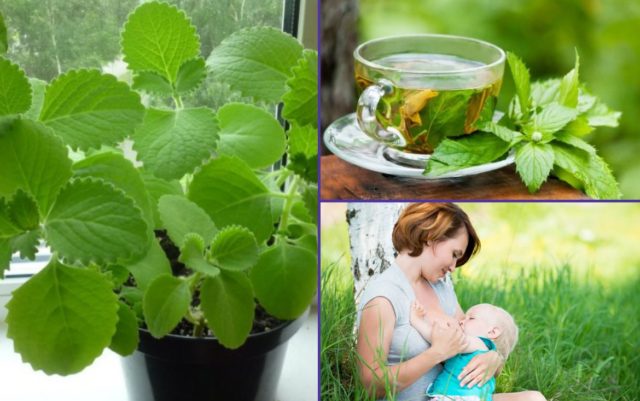
When breastfeeding, it is better to refuse mint and lemon balm
Is peppermint possible for children
Doctors have no consensus on this matter. But everyone agrees that until the age of 3, children should not be given infusions and decoctions of peppermint. Later, you need to consult a pediatrician and do not rush - the light did not converge on this medicinal herb.
The characteristics of peppermint are such that it acts as a sedative. On the child's body - very much. All parents have their own criteria for behavior, even teachers cannot always correctly determine whether it is worth calming a child with medication. This is the task of doctors.
It is necessary to introduce peppermint into the child's diet gradually, from one leaf. And only when the parents have the opportunity to watch the baby for at least an hour. If after a cup of tea he becomes lethargic, sleepy, you need to forget about mint for at least six months. In the case when hives, swelling, itching, any discomfort appear, you should urgently consult a doctor.
What Peppermint Treats and How to Take It Right
Peppermint effectively treats many diseases, from acne to pre-infarction conditions. It is usually used in therapy:
- of cardio-vascular system;
- hypertension;
- respiratory organs;
- colds;
- Gastrointestinal tract;
- musculoskeletal system;
- nervous system;
- skin diseases.
To alleviate conditions with stones in the gallbladder and kidneys, peppermint is used only under the supervision of a physician.
For a good sleep
Insomnia is often caused by internal stress, overwork, depression, stress, anxiety. Drinking tea with a few peppermint leaves is sometimes sufficient to help you fall asleep.
In especially advanced cases, it is good to drink fruit juice with a high content of sucrose, for example, grape or pineapple juice, adding a teaspoon of ground peppermint to it. This increases the level of serotonin, which helps you fall asleep. The effect is not worse than that of sleeping pills, but much tastier and healthier. It must be drunk slowly, in small sips.
In the room of a hyperactive child, whom it is impossible to calm down and put to sleep in the evening, it is recommended to hang several sprigs of peppermint. Or place dry leaves on the nightstand next to the bed.
With a cold
Peppermint, along with viburnum and raspberries, is one of the most effective home remedies for colds. The disease, in addition to fever, inflammatory processes, is usually accompanied by loss of appetite, general weakening of the body, pain, insomnia. When treating this "bouquet", peppermint has an advantage over berries.
Everyone knows how to drink ordinary tea with this herb. In severe cases, a drink is recommended that acts as a balm, helps to cope with the disease without drugs. If a person is allergic to any component, it is simply removed from the recipe.
Pour boiling water over mint, raspberry jam, lemon to taste. Add 1/4 tsp. ground ginger and turmeric. Cover with a lid, wrap, leave for 30 minutes. Add honey to taste. Drink 5-6 glasses a day.

Tea with mint and lemon is good for colds.
How to take peppermint cough suppressants
Cough is the body's way of getting rid of substances accumulated in the respiratory tract, including phlegm. Sometimes it is caused by smoking or neurosis. Peppermint helps to get rid of dry, nervous cough, enhances the secretion of phlegm, prevents the growth of microbes, and heals inflammation.
An excellent remedy is tea made from peppermint, lemon, honey. If drug treatment is not going on in parallel, 1/4 tsp can be added to the glass. turmeric.
Is it possible to peppermint with gastritis
Inflammation of the inner walls of the stomach is accompanied by pain, colic, loss of appetite, nausea, and bad breath. Dizziness, vomiting, nervous tension, salivation, heartburn are often observed.
With all the causes and symptoms of increased or normal acidity, peppermint infusion will help to cope. For its preparation 1 tsp. dry crushed leaves are poured with a glass of boiling water, covered with a lid and heated in a water bath for 15 minutes. Wrap up, insist 45 minutes.
It is taken warm in 70-100 ml half an hour before breakfast, before lunch and dinner - 15-20 minutes. They drink in small sips.
Does peppermint help with pancreatitis?
There can be many reasons for inflammation of the pancreas - from heredity and alcoholism to worms and allergies. But most often, pancreatitis occurs as a result of duodenal ulcers or gallstone disease.
Peppermint is not capable of curing the pancreas, but it will help alleviate the condition. For this, 1 tbsp. l. dry leaves are poured into 0.5 liters of boiling water, covered, wrapped, insisted for 30 minutes, filtered. Three times a day, half an hour before meals, drink 1/3 cup. At this time, sugar cannot be eaten in any form, sweeteners are completely excluded from the diet.
Is it possible to mint for diabetes
High blood sugar is the result of insufficient or no production of insulin by the body. A delicious cocktail can relieve the condition. A glass of freshly squeezed grapefruit is mixed with a tablespoon of mint juice. In winter, replace the last ingredient with a teaspoon of leaf powder. Two glasses a day are enough.
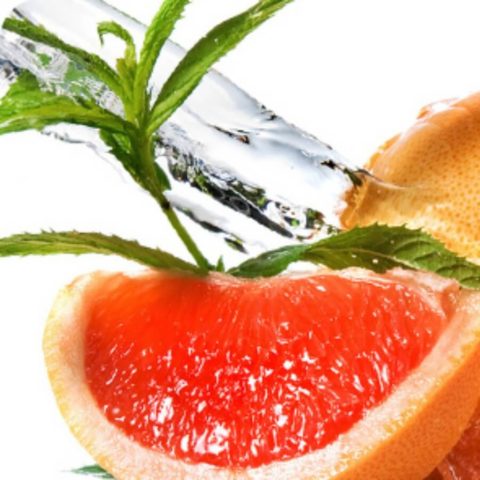
Grapefruit and mint juice can help with diabetes
Raises peppermint pressure, or lowers
High blood pressure, impaired vascular tone, and so are treated with preparations of peppermint.As an auxiliary or prophylactic agent, you can take the tincture. For this, a tablespoon of dry leaves is poured into 0.5 liters of boiling water, heated for 15 minutes in a water bath, and insisted for 45 minutes. Strain, mix to taste with honey, jam from apricots, raspberries, hawthorn or sea buckthorn. Drink during the day. Course - month.
Peppermint uses
The plant has found application in all spheres of life. Peppermint is used:
- official and traditional medicine for the treatment of a wide range of diseases;
- cosmetology;
- perfume industry;
- for making cocktails, teas, various dishes;
- during the renovation of premises;
- to scare away insects;
- as a spicy aromatic plant;
- to decorate the site.
Medicinal uses of peppermint
The properties of peppermint are well studied and are widely used by official medicine. It is included in many dosage forms. It is difficult to name a disease for the treatment of which there is not at least one drug containing mint. The most famous:
- alcohol tincture;
- peppermint oil;
- Validol;
- Zelenin drops;
- mint tablets;
- Pectusin;
- Menovazine;
- aerosols Camphomenes and Ingacamp;
- Anestezol candles;
- Olimetin;
- Efkamon ointment;
- balm Asterisk;
- Boromenthol.
In cosmetology
Peppermint is found in proprietary and homemade beauty and hygiene products. Its relevance is due to its anti-inflammatory, antiseptic, antibacterial properties. Peppermint essential oils irritate nerve endings, which causes blood flow and enhances skin regeneration.
Skin care
Water and alcohol infusions, lotions made from peppermint, disinfect the skin, treat cuts, irritations. They are especially useful for eliminating excess oiliness, acne, acne.
For the treatment of purulent inflammations, it is enough to knead a few leaves of fresh mint and apply to the skin. After 20 minutes, the gruel is washed off with cool water.
Mint:
- tones the skin of the face;
- strengthens capillaries;
- removes toxins;
- improves blood circulation;
- relieves inflammation and irritation;
- reduces itching;
- prevents the appearance of wrinkles;
- relieves fatigue from the eyes.
For irritated, oily, aging skin, rubbing with ice cubes from frozen mint infusion or broth is useful. The procedure is done in the morning and in the evening.
Peppermint water is a great remedy:
- for removing makeup;
- cleaning the skin;
- preparing the face for applying the cream.
Men can replace shaving products with mint broths or infusions. They tend to tone and soothe irritated skin.

Peppermint protects the skin from wilting
Hair care
Peppermint is a component of many shampoos and other hair care products. Rinsing with a decoction of this herb has the ability to eliminate dandruff, reduce itching, and relieve fatigue. In hot weather, this procedure cools the scalp.
In folk medicine
Traditional medicine uses peppermint to treat the same ailments as the official one. Only he does not use drugs, extracts or extracts, but teas, infusions and decoctions.
Peppermint tea
To prepare mint tea, 3-5 leaves are enough, pour a glass of boiling water and leave for 5-10 minutes. If desired, you can combine the herb with black or green tea leaves. Sugar, honey, lemon are used as additives.
Decoction
Pour 2 teaspoons of chopped leaves with a glass of boiling water, cover with a lid. Warm up in a water bath for 15 minutes. Wrap up. Insist 30 minutes. They are filtering.
Infusion
Pour a tablespoon of crushed peppermint flowers or leaves with a glass of boiling water. Close with a lid - essential oils tend to volatilize. Wrap up, insist for 30 minutes. They are filtering. If you do not drink it per day, store it in the refrigerator for no more than 2 days.
Tincture
Pour 10 g of dried leaves or flowers of peppermint with 100 ml of vodka. Insist for a week in a sealed glass container at room temperature, placing in a dark place. Shake the container periodically. They are filtering. Store in a glass bottle in a cool, dark place.
Toning baths
An excellent tonic is a bath with aromatic dried herbs containing peppermint. For its preparation, take a tablespoon:
- thyme;
- rosemary;
- peppermint.
Pour a liter of boiling water, cover with a lid. Insist 15 minutes. Strain and add to the bathroom. It is not recommended to do the procedure for more than 15 minutes.
In cooking
Peppermint is used in cooking as a spicy aromatic plant for preparing drinks and various dishes. It has a strong, pleasant, spicy scent and refreshing properties.
As a perfume, peppermint is widely used in the alcoholic beverage industry. Dry leaves are used to flavor vinegar and tea. Shoots are placed in jars when pickling cucumbers.
It is peppermint that is used in the preparation of many cocktails. Fresh leaves are used to decorate desserts and other dishes.
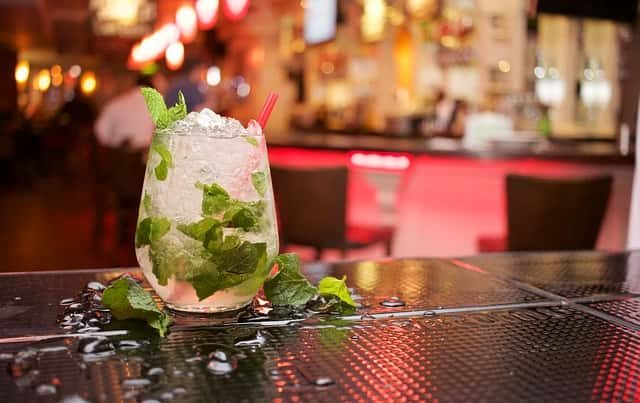
Peppermint is found in many cocktails
What dishes are peppermint added to
Dried and fresh peppermint leaves are used in cooking. They go well with stewed vegetables, especially cabbage, leeks, and legumes. The herb is added to marinades, sauces for cheese, meat and fish dishes. Small amounts of mint are added to some soups.
The leaves are used to decorate and add a refreshing flavor to desserts. Mint is a part of candies, and mint candies are especially popular. It is irreplaceable for sweet sauces.
Slimming
Although mint is low in calories, there is no diet based on it. Tea made from flowers and leaves is used as a weight loss aid due to the following properties:
- Has a calming effect. When a person goes on a diet, he experiences stress. Especially if he likes to eat deliciously. Peppermint helps to put in order the nervous system, thereby reducing the likelihood that losing weight "breaks out" from the diet.
- Strengthens the outflow of bile. It promotes digestion and breakdown of fats.
- Destroys pathogenic microorganisms in the gastrointestinal tract.
- Soothes the stomach and intestines.
At home
Peppermint aromatic oils improve the air in the house, destroy pathogenic microorganisms. They are even used to sanitize rooms infected with mold.
Rodents do not like the mint smell. It can be planted around buildings in the private sector. True, this saves only during the growing season of the plant.
You can displace dry mint leaves with baking soda, sprinkle evenly over the carpet. Vacuum after an hour. This will refresh the product, if it is not possible to give it to cleaning, and will destroy the dust mites living there.
The scent of mint, especially peppermint, will scare away mosquitoes, ants, fleas, flies. But as soon as it wears off, the insects will return.
The site of a mosquito bite will itch less if you rub it with a fresh mint leaf. Pepper is most effective due to its high menthol content.

Unlike cats, mosquitoes do not like mint.
Contraindications to the use of peppermint
With all medicinal herbs, you need to be careful, they will bring benefit or harm, depending on the dose. Peppermint is no exception. Of course, to die, you need 400 g of essential oil, and it contains no more than 3% in the leaves and up to 6% in the flowers.
Through simple mathematical calculations, 4 kg of medicinal raw material (plant without roots and stems) is obtained at a time. It is physically impossible to eat so much. If anyone tries, they will just vomit.
But these are extremes. Even when taken in moderation, mint can cause allergies.Most often, the reaction is to menthol, but other components are also the cause.
Side effects of peppermint are usually seen with prolonged use. If a person drinks tea with fresh or dried leaves several times a week, it's okay. But when infusions or decoctions are regularly used without taking breaks, this can lead to the following consequences:
- venous tone decreases, which provokes an exacerbation of already existing diseases - varicose veins, thrombophlebitis, hemorrhoids;
- constant drowsiness does not allow to get up in the morning, makes it impossible to drive vehicles;
- headaches begin;
- reproductive function temporarily decreases.
There are rare but documented cases of urinary incontinence. After a month of consuming mint in infusions, decoctions and tinctures, you should definitely take a break. An exception is when therapy is carried out under the supervision of a doctor, and he monitors the patient's condition.
Among the direct contraindications to the use of peppermint:
- low pressure;
- lactation;
- phlebeurysm;
- low acidity;
- allergy to peppermint;
- male and female infertility.
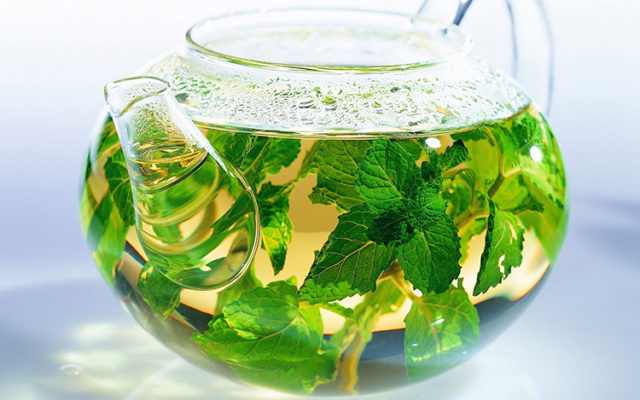
If menthol is poorly tolerated, even tea with peppermint should be discarded.
If menthol is poorly tolerated, even tea with peppermint should be discarded.
Conclusion
The medicinal properties and contraindications of peppermint are incomparable when used correctly. You can drink tea in moderate doses all the time, but you need to take breaks while taking broths and infusions.








